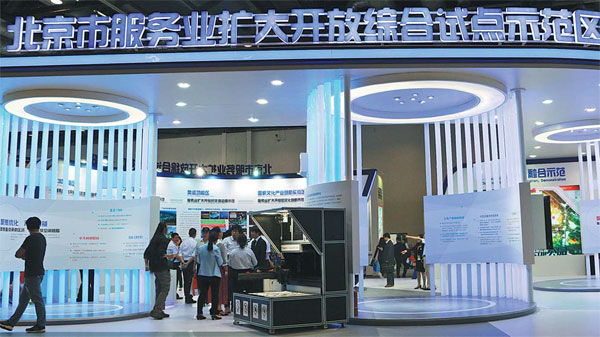CIFTIS brings world together to explore future of industry
|
Visitors gather business information at the innovation zone of Beijing's Chaoyang district during the 2017 Beijing International Fair for Trade in Services. Last year, the added value of the district's service industry reached 465.9 billion yuan ($68 billion) with modern services, including finance and technology, accounting for over 67 percent of its GDP. Li You / China Daily |
As demand rises, more countries look to emerging sector for opportunities in globalization
The 2017 Beijing International Fair for Trade in Services, one of China's largest service sector trade fairs, kicked off on Sunday, offering a communication platform for global service trade and a showcase for the latest innovations.
Fang Aiqing, vice-minister at the Ministry of Commerce, said during the keynote forum that in the process of economic globalization, the role of trade in services has become increasingly prominent.
In 2016, the global service export volume hit $4.77 trillion, accounting for 23.5 percent of total trade exports, an increase of 4.4 percentage points over the year 2011.
The service sector has created 70 percent of the world's GDP and 45 percent of jobs.
In developed economies, services contribute as much as 75 percent of GDP, and employ two-thirds of the local workforce, according to Mari Kiviniemi, deputy secretary-general of the Organization for Economic Cooperation and Development.
The 2017 CIFTIS is the right forum to address the need for a constructive and collaborative discussion on trade and investment, and to seek new ways to ensure that all parts of society can benefit more equitably from trade, Kiviniemi said.
Hamid Mamdouh, director of Trade in Services division of the WTO, said that China is right in putting services at the center of its focus.
The transformation of the global economy has been taking place at a dazzling pace with unprecedented complexity.
At the center of all this is the rapid development of sophisticated and efficient services, driven by technology, global finance and innovative business models, Mamdouh said.
"The service industry is one of the key indicators to measure the development of countries and regions," said Zhang Gong, executive vice-mayor of Beijing.
In 2016, the added value of Beijing's service industry reached 2 trillion yuan ($292 billion), up by 7.1 percent from the previous year, accounting for more than 80 percent of Beijing's local GDP.
The total volume of service trade hit $150 billion in 2016, according to Zhang.
To further provide an impetus to trade in services at the regional level, the Chinese government has established 11 free trade test areas and 15 new zones to carry out plans for innovative service trade.
In Beijing, Chaoyang district's services sector brought a comprehensive exhibition to the fair, where 16 projects from more than 40 enterprises and organizations from eight countries will reach cooperation agreements. The total contract value is expected to exceed 100 billion yuan.
The district has more than 2,000 high-tech enterprises and 1,515 financial institutes.
Gui'an New Area in Guizhou is participating in the fair, highlighting its innovative enterprises in the fields of big data services trade, modern agriculture, construction technology and cultural industries.
"We are here to search for new opportunities to attract enterprises to launch their projects in Gui'an New Area. As a new emerging industrial area, our advantages are our livable environment and high-end talent," said Fan Xiaojiang, member of the management committee of Gui'an New Area.
Sichuan is showcasing its achievements in trade in services through diverse cultural products and innovative industries on the fair.
Since last year when Chengdu was approved to become a national-level test city for trade in services, the city made a 20 percent increase in total volume in the sector in 2016.
Jiangsu province is unveiling its charm through two different exhibition areas.
One displays ancient traditional stitch work, the other demonstrates progress in the Nanjing Jiangbei New Area, where a global chip center is on its way to completion.
Zhejiang has applied big data technology to its ancient textile industry and is exhibiting its smart eldercare services using internet technology at the fair.
Adhering to the concept of "openness, innovation and integration", the 2017 fair focuses on the Belt and Road and will hold 85 seminars and exchange activities from May 28 to June 1 in Beijing's China National Convention Center, covering the fields of scientific technology, information services, traditional and cultural industries as well as healthcare services.
liyou@chinadaiy.com.cn



















